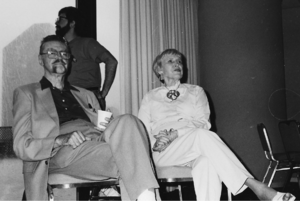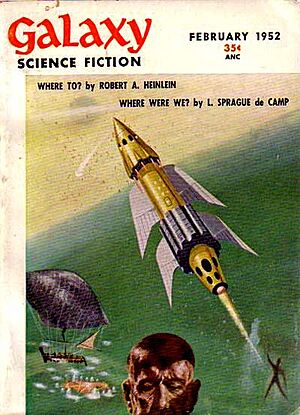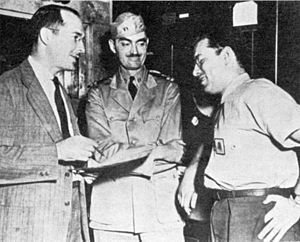L. Sprague de Camp facts for kids
Quick facts for kids
L. Sprague de Camp
|
|
|---|---|

L. Sprague and Catherine Crook de Camp at Nolacon II in 1988
|
|
| Born | Lyon Sprague de Camp November 27, 1907 New York City, U.S. |
| Died | November 6, 2000 (aged 92) Plano, Texas, U.S. |
| Pen name | Lyman R. Lyon (one story), J. Wellington Wells |
| Occupation |
|
| Nationality | American |
| Period | 1937–1996 |
| Genre | Science fiction, fantasy, alternate history, historical fiction, history |
Lyon Sprague de Camp (born November 27, 1907 – died November 6, 2000) was an American author. He wrote many books in different genres, including science fiction, fantasy, and non-fiction. Over his 60-year career, he wrote more than 100 books. He was a very important writer in science fiction during the 1930s and 1940s.
Contents
About L. Sprague de Camp
Sprague de Camp was born in New York City. His father worked in real estate and lumber. Sprague was one of three sons. His grandfather, Charles Ezra Sprague, was a well-known accountant and banker who fought in the Civil War. Sprague de Camp once said that his real name sounded more like a made-up name than most pen names!
Early Life and Education
De Camp went to the Trinity School in New York. Later, he spent ten years at the Snyder School in North Carolina, which was a military-style school. His parents sent him there because they wanted him to be more disciplined. He was thin and not very good at fighting, so other students sometimes picked on him. These experiences taught him to be very logical and analytical. Even though some people thought he seemed a bit cold, he could also be very funny. He later wrote about these tough childhood times in a story called Judgment Day (1955).
Sprague de Camp studied to become an aeronautical engineer. He earned his first degree from the California Institute of Technology (Caltech) in 1930. He then got his Master's degree in Engineering from the Stevens Institute of Technology in 1933. Besides being an engineer, he was also a surveyor and an expert in patents.
His first job was with a company called Inventors Foundation, Inc. in New Jersey. He later worked for The International Correspondence Schools. In 1937, he left his job as the head of the School of Inventing and Patenting. His first book, Inventions and Their Management, came out that same year.
Family and Collaborations
On August 12, 1939, de Camp married Catherine Crook de Camp. They often worked together on science fiction and non-fiction books starting in the 1960s. They had two children.
During World War II, de Camp worked as a researcher at the Philadelphia Naval Yard. He worked alongside other famous writers like Isaac Asimov and Robert A. Heinlein. De Camp became a lieutenant commander in the U.S. Navy. From 1942 to 1989, the de Camps lived near Philadelphia, mostly in Villanova, Pennsylvania.
De Camp was part of a men's club in New York City called the "Trap Door Spiders." This club inspired Isaac Asimov's fictional group of mystery solvers, the "Black Widowers." De Camp himself was the inspiration for the character named "Geoffrey Avalon."
He was also a founding member of the Swordsmen and Sorcerers' Guild of America (SAGA). This was a group of Heroic fantasy writers who joined based on their writing skills.
Later Life
In 1989, the de Camps moved to Plano, Texas. Sprague de Camp passed away there on November 6, 2000, at the age of 92. This was seven months after his wife passed away, and on what would have been her birthday. His ashes, along with his wife's, were buried in the Arlington National Cemetery in Virginia.
In 2005, about 1,200 books from de Camp's personal library were sold at an auction. This collection included books signed by other writers like Isaac Asimov and Carl Sagan, as well as by de Camp himself.
Did You Know? "Extraterrestrial" and "E.T."
The word "extraterrestrial" means "from beyond Earth." It was used as an adjective as early as 1868. H. G. Wells likely used it first in connection with life beyond Earth in his 1898 novel The War of the Worlds.
However, L. Sprague de Camp is known for being the first to use "extraterrestrial" as a noun, meaning "alien life." He also coined the short form "E.T." He did this in his article "Design for Life," which was published in Astounding Science Fiction magazine in May 1939.
Sea Serpent Sightings Theory
In 1968, de Camp suggested that discoveries of fossils might have influenced modern reports of sea monster sightings. He wrote about this idea in an article called "Dinosaurs in Today's World." Later, in 2019, scientists C. G. M. Paxton and D. Naish studied de Camp's theory. They found that the way sea monster sightings were reported seemed to support his idea.
His Writing Style
De Camp was a materialist, meaning he focused on facts and logic. He wrote about society, history, technology, and myths. He published many short stories, novels, non-fiction books, and poems.
He often had a goal to correct mistakes or illogical ideas he saw in other authors' works. He was a very logical thinker and was bothered by things that didn't make sense in stories. For example, he didn't like to use scientific ideas like faster-than-light travel if he thought they were impossible.
When he read Mark Twain's A Connecticut Yankee in King Arthur's Court, he wrote his own time travel novel called Lest Darkness Fall. In his story, the time travel was explained in a more logical way. The hero's technical skills were also more realistic for the time period.
He also explored space opera and planetary romance in his "Viagens Interplanetarias" series. In his Pusadian series, he reimagined ancient civilizations. When he wasn't correcting ideas, he was often explaining them. For instance, in the Harold Shea stories he wrote with his friend Fletcher Pratt, they explored how magic in myths and legends could work with its own set of rules.
Science Fiction Works
De Camp's science fiction often showed his interest in languages, ancient history, and the history of science. His first published story was "The Isolinguals" in 1937. Many of his early science fiction stories were stand-alone. However, he did write the "Johnny Black" tales about a black bear who became as smart as a human. He also wrote "Drinkwhiskey Institute" stories, which were funny tales about time travel.
His stories about time travel and alternate history, like Lest Darkness Fall (1939) and "A Gun for Dinosaur" (1956), were very important. He showed how technological advances could change history, proving that history wasn't just a series of random events. These works are considered groundbreaking in the field of alternate history.
His longest series was "Viagens Interplanetarias." These stories are set in a future where Brazil is a powerful nation. A part of this series, the "Krishna" novels, are sword and planet stories set on the planet Krishna. His novel Rogue Queen from this series was very influential. It told the story of a hive society that changed after meeting people from other planets.
Fantasy Works
De Camp was well-known for his lighthearted fantasy stories. He often wrote these with his friend Fletcher Pratt. Their most famous collaborations were the Harold Shea stories (starting in 1940) and the Gavagan's Bar stories (starting in 1950). They also wrote other stand-alone novels together, like Land of Unreason (1942).
He was also important in the world of sword and sorcery fantasy. He helped bring back the popularity of Robert E. Howard's Conan stories by editing and continuing them. He also edited fantasy collections that helped spark new interest in heroic fantasy in the late 1960s.
De Camp created his own sword and sorcery series too:
- The Pusadian series (from 1951) includes the novel The Tritonian Ring. These stories are set in a very ancient time, similar to Howard's stories.
- The Novarian series (from 1968) includes the "Reluctant King" trilogy: The Goblin Tower, The Clocks of Iraz, and The Unbeheaded King. These stories follow the adventures of Jorian, a former king.
- The Incorporated Knight series includes short stories and two novels written with Catherine Crook de Camp: The Incorporated Knight (1988) and The Pixilated Peeress (1991). These stories are set in an alternate medieval world.
Historical Fiction Works
De Camp also wrote historical fiction. These novels were set in ancient times, from the powerful First Persian Empire to the end of the Hellenistic period. Five of his novels, published between 1958 and 1969, are loosely connected. They all focus on how scientific knowledge advanced in those times. His main characters were often explorers, engineers, or thinkers, rather than just famous historical figures. His best-known historical novel is The Dragon of the Ishtar Gate.
Nonfiction Works

De Camp's first non-fiction book was Inventions and Their Management, published in 1937.
He enjoyed debunking (showing that something is false) doubtful history and pseudoscientific claims about the supernatural. He did a lot of research for a book about magic and witchcraft. In 1976, he joined the Committee for Skeptical Inquiry. This group was formed to investigate claims of the paranormal. Even though he wrote fantasy, de Camp did not believe in ghosts in a supernatural way. He believed in using facts and measurable data to prove claims.
He also wrote about how ancient civilizations built amazing structures like the Pyramids of Ancient Egypt. Many people thought these structures were impossible for ancient people to build. His books in this area include Lost Continents, Citadels of Mystery, and The Ancient Engineers.
Some of his other non-fiction books covered topics like the Scopes Trial (a famous court case about teaching evolution), the history of inventions, and dinosaurs. His book "Language for Time Travelers" (1938) explored how difficult it would be for time travelers to communicate as language changes over time.
De Camp also wrote important biographies of fantasy writers like Robert E. Howard and H. P. Lovecraft. These were the first major independent biographies of these authors. He tried to show a complete picture of his subjects, including their flaws.
Awards and Honors
De Camp and Willy Ley won the 1953 International Fantasy Award for their book Lands Beyond, which was about geographical myths. De Camp was honored at the 1966 World Science Fiction Convention. He was named the third Gandalf Grand Master of Fantasy in 1976, after J.R.R. Tolkien and Fritz Leiber.
The Science Fiction Writers of America made him its fourth SFWA Grand Master in 1979. He won the World Fantasy Award for Life Achievement in 1984. In 1996, he received a special Sidewise Award for Alternate History for his important works in that field. He also won the Hugo Award for Nonfiction in 1997 for his autobiography, Time and Chance.
In 2011, de Camp was added to the Pantheon of Skeptics by the Committee for Skeptical Inquiry (CSI). This honor remembers people who contributed to scientific skepticism.
Selected Books
This list includes some of his most important books.
Science Fiction
- Lest Darkness Fall (1939) – An early alternate history novel that is still popular today.
- The Wheels of If and Other Science Fiction (1948) – A collection of his early short stories.
- Genus Homo (1950) (with P. Schuyler Miller) – Possibly one of the first stories with a "Planet of the Apes" theme.
- The Hand of Zei (1950) – One of the best early "Krishna" novels from his Viagens Interplanetarias series.
- Rogue Queen (1951) – A famous novel about a hive society.
- The Glory That Was (1960) – A book that combines many of de Camp's interests.
- A Gun for Dinosaur and Other Imaginative Tales (1963) – A collection of some of his best early stories.
Fantasy
- The Incomplete Enchanter (1941) (with Fletcher Pratt) – The first book in the popular Harold Shea series.
- Land of Unreason (1942) (with Fletcher Pratt) – A highly regarded fantasy novel.
- The Undesired Princess (1951) – One of de Camp's first major fantasy books not written with Pratt.
- Tales from Gavagan's Bar (1953) (with Fletcher Pratt) – A collection of stories from their second major fantasy series.
- The Tritonian Ring and Other Pusadian Tales (1953) – Stories from his Pusadian series.
- Tales of Conan (1955) (with Robert E. Howard) – This book helped make Conan the Barbarian famous.
- The Goblin Tower (1968) – The first book in his Novarian series.
- The Fallible Fiend (1973) – A unique story from the Novarian series told from a demon's point of view.
Historical Fiction
- The Dragon of the Ishtar Gate (1961)
- The Arrows of Hercules (1965)
- An Elephant for Aristotle (1958)
- The Bronze God of Rhodes (1960)
- The Golden Wind (1969)
Anthologies
- Swords and Sorcery (1963) – A pioneering collection of sword and sorcery stories.
Nonfiction
- Inventions and Their Management (1937) (with Alf K. Berle) – His first non-fiction book.
- Lands Beyond (1952) (with Willy Ley) – A detailed look at geographical myths.
- Science-Fiction Handbook (1953) – An important guide for science fiction writers.
- Lost Continents: the Atlantis Theme in History, Science, and Literature (1954) – Explores the legend of Atlantis.
- The Ancient Engineers (1963) – A thorough history of practical science before modern times.
- The Great Monkey Trial (1968) – A popular account of the famous Scopes Trial.
- Lovecraft: A Biography (1975) – The first major biography of H. P. Lovecraft.
- Literary Swordsmen and Sorcerers (1976) – A study of modern fantasy authors.
- Dark Valley Destiny: the Life of Robert E. Howard (1983) (with Catherine Crook de Camp and Jane Whittington Griffin) – The first major biography of Robert E. Howard.
- Time and Chance: an Autobiography (1996) – His autobiography, which won an award.
See also
 In Spanish: L. Sprague de Camp para niños
In Spanish: L. Sprague de Camp para niños




